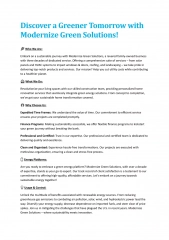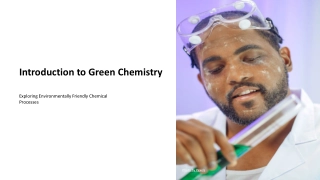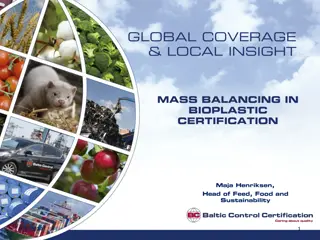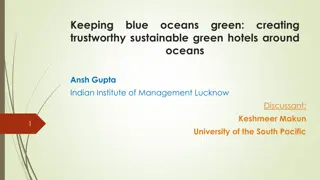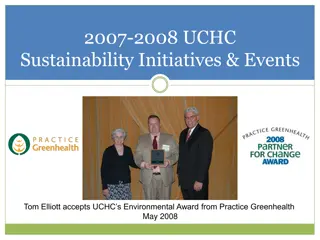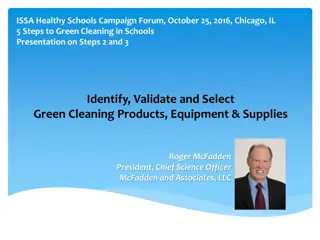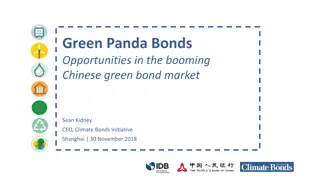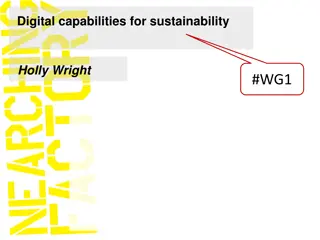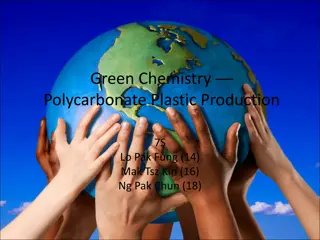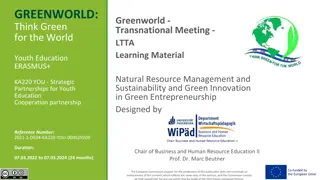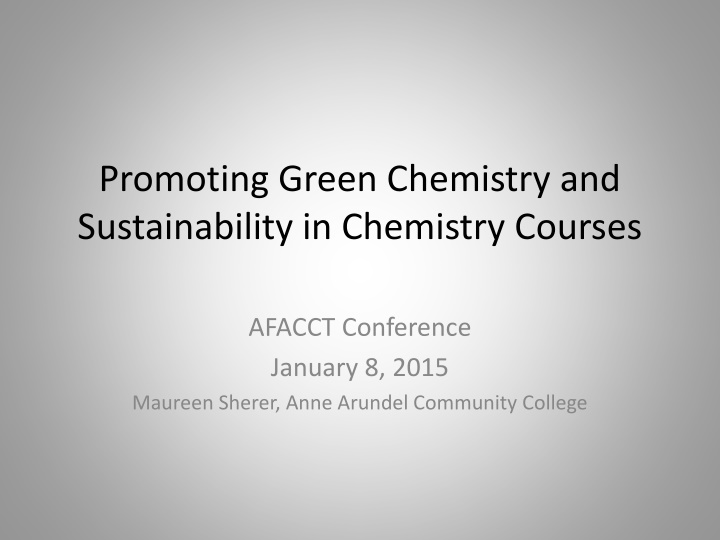
Promoting Green Chemistry and Sustainability in Chemistry Courses
Explore the importance of green chemistry in building a healthier future, incorporating the 12 principles of green chemistry, and implementing new experiments with a greener footprint. Discover case studies and examples like the green synthesis of divanillin, offering students practical and safe synthetic chemistry techniques. Embrace a sustainable approach in teaching chemistry for a cleaner and safer environment.
Download Presentation

Please find below an Image/Link to download the presentation.
The content on the website is provided AS IS for your information and personal use only. It may not be sold, licensed, or shared on other websites without obtaining consent from the author. If you encounter any issues during the download, it is possible that the publisher has removed the file from their server.
You are allowed to download the files provided on this website for personal or commercial use, subject to the condition that they are used lawfully. All files are the property of their respective owners.
The content on the website is provided AS IS for your information and personal use only. It may not be sold, licensed, or shared on other websites without obtaining consent from the author.
E N D
Presentation Transcript
Promoting Green Chemistry and Sustainability in Chemistry Courses AFACCT Conference January 8, 2015 Maureen Sherer, Anne Arundel Community College
Why Green Chemistry? Building a healthier future. Supporting recommendations of American Chemical Society (ACS) as a component of undergraduate curriculum. Meeting industry & international guidelines. 2
12 Principles of Green Chemistry 1. Prevent waste 2. Atom Economy 3. Less Hazardous Synthesis 4. Design Benign Chemicals 5. Benign Solvents & Auxiliaries 6. Design for Energy Efficiency 7. Use of Renewable Feedstocks 8. Reduce Derivatives 9. Catalysis (vs. Stoichiometric) 10. Design for Degradation 11. Real-Time Analysis for Pollution Prevention 12. Inherently Benign Chemistry for Accident Prevention www.acs.org/greenchemistry 3
How? Introduce new experiments with a Greener Footprint . Re-evaluate existing experiments according to Green Chemistry Principles. Case Studies for Students to Analyze. 4
Green Synthesis of Divanillin Adapted from Nishimura, R.T.; Giammanco, C.H.; Vosburg, D.A., J. Chem. Educ. 2010, 87, 526-527. 2 O + H2O2 + 2 H2O H O H OH peroxidase OCH3 O OCH3 H3 C pH 4 OH OH H O Divanillin Vanillin 5
Divanillin Students practice important synthetic chemistry techniques. No hazardous exposures. Minimal waste. Good results. Readily adaptable to sophomore organic or to freshman bio-chemistry. 6
Potassium Ion Concentration Determined by Atomic Absorption Spectroscopy (AAS) State-of-the-art instrumental method. No hazardous waste. AACC AAS is a Perkin Elmer AAnalyst 200. 8
Re-evaluating Existing Experiments Cost-Benefit Analysis For each experiment, consider: Materials. Energy Inputs. Scale (Macro or Semi-Micro). Water Required (Cooling, suction, clean-up). Atom Economy. Waste/Clean-up. Skills and Concepts Taught. 10
New Technologies & Methodologies to Consider Electric pump rather than water aspiration for suction filtration. Microwave oven for heating. Computer simulations and molecular modelling. Metrics to evaluate green-ness , (e.g. Sean M. Mercer, et al, J Chem Ed, 2012, 89, 215-220). Others 11
Some Old Ways Are Important Too Students still need to know proper protocols for the safe handling and ultimate disposal of materials. This is part of the learning students need to acquire in general and organic chemistry courses. Students learn by doing. 12
Students Analyzing Case Studies & Investigating Green Chemistry Principles Building critical thinking skills. Promoting sustainable practices. Opportunity for our daily lives. 13
Investigating Green Chemistry Principles Using a Worksheet Students are given a worksheet which directs them to several websites about green chemistry, life cycle perspective, Safety Data Sheets (SDS), the Globally Harmonized System (GHS), and others. Students have a set of questions to answer about what they learn from reading the websites. This prepares them to analyze case studies. 14
Case Study Example Ethylenediaminetetraacetate (EDTA) vs. Iminodisuccinate (IDS) EDTA degrades slowly in the environment, during this time it can leach heavy metals into the groundwater. IDS is nontoxic & readily degrades in the environment so leaching problem is circumvented. 15
Case Study, continued Students are given some information about EDTA & IDS to read. Students then list and explain the relevant Green Chemistry Principles which support the use of IDS (in cases where they are interchangeable). Please see handout for more details. 16
Other Case Studies Involve Use of Liquid CO2 as a Nonpolar Solvent, rather than Diethyl Ether, etc. Use of nitrate reductase in the quantitative determination of nitrate in the aquatic environment, rather than Cd/Cu. Semi-micro scale experiments rather than macro scale. Comparing two different syntheses for a given compound. 17
Green Chemistry Resources ACS Green Chemistry Institute. U.S. EPA - Risk Management, Green Chemistry and Engineering. Green Chemistry at the University of Oregon. The Berkeley Center for Green Chemistry. Green Chemistry at the University of Toronto. Beyond Benign. ACS Webinars on Green Chemistry. Please see handout for web addresses. 18
Discussion Your Ideas Let s stay in touch to share ideas and resources Maureen Sherer, masherer@aacc.edu 19
Acknowledgements Debbie Reeder, AACC Chemistry Lab Manager. The AACC Chemistry Lab Staff. 20

